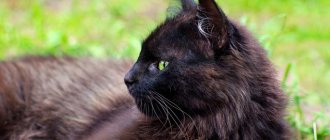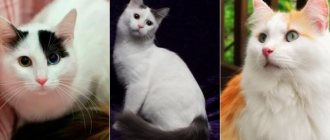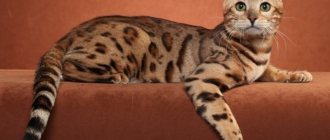History of the Arabian Mau breed
The Arabian Mau is a breed of short-haired cat of indigenous origin. The Arabian Mau is believed to have descended from the wild steppe cat of the Arabian Peninsula. Wild cats used to live in deserts and steppes in the Middle East (United Arab Emirates, Oman, Qatar and Kuwait). These cats are believed to have originated over 1,000 years ago.
Arabian Mau originated naturally
As cities grew, wild cats began to choose habitats closer to people. There was more food in populated areas, and it was more comfortable to sleep in a warm house than on the street. Local residents are so used to animals that they stopped paying attention to them. It was considered fashionable to purchase purebred cats and cats brought from abroad.
It was only in 2004 that attention was paid to street Arabian cats. The president of the Middle Eastern Cat Fanciers Association (MECATS), Petra Muller, organized a real wild cat nursery and began breeding and preserving the breed. The official breeding program for these animals gained momentum; in 4 years, 4 generations of animals (18 individuals) were obtained. In 2008 the breed was officially recognized by the WCF.
Despite the fact that Arabian cats are mostly strays, they are loved and respected. Arab Muslims believe that the Prophet Muhammad had a cat named Muezza. The great prophet cut his sleeves so as not to wake up the cat sleeping on him. That's why even stray cats are allowed into the mosque. In our city (Penza) the doors of mosques are open to any cats. This suggests that the first cats appeared a long time ago, becoming the object of ancient legends.
general characteristics
The closest relative of wild cats is the Arabian Mau - a large, muscular and very graceful animal, whose weight sometimes reaches 8 kg. This is a natural breed that inherited extraordinary endurance and excellent hunter qualities from its desert-hardened wild ancestors.
Mau are distinguished by amazing devotion to their owner and friendly attitude towards all household members. At the same time, they are wary and distrustful of strangers.
The owner of such a pet need not worry about his home, which the Mau cat remains to guard. At home, the life expectancy of this breed is on average 14 years.
Description of the Arabian breed
The appearance, character and habits of the animal were formed over many years. The first Arabian cats were unadapted to life in the wild desert conditions. Desert dune cats bred with domestic pets, passing on beneficial genes to Arabian cats. Nature did the rest. The cat's physique, intelligence and even color allow it to survive in any hot conditions.
The appearance of the modern Arabian cat is the result of natural selection
Appearance of Arabian cats
Arabian Mau cannot be called small cats, although they are slender. The weight of an adult male can reach 8 kg, females - 4 kg. The slender Arabian woman looks graceful. The cat seems even more graceful thanks to its slender limbs and elongated, elongated body. The cat's body is not thin, it is quite muscular.
The animal's tail is of medium length and tapers towards the tip. People who do not understand breeds, when they see an Arabian cat for the first time, will decide that this is an ordinary yard cat. However, there are a number of striking characteristics that distinguish this animal from representatives of other breeds.
Yes, their color, in general, is reminiscent of Russian courtyards, although it seems to me that this is precisely the peculiarity of the Arabian Mau - very clear spots, most often black and white, I have observed many cats that resembled cows in color.
Arabian Mau, forum user
https://mauforum.ru/viewtopic.php?p=692730
The main distinguishing features of Arabian cats are huge ears and a sharp chin.
The cat's head is round with well-defined whisker pads. The profile is curved, the chin protrudes noticeably. Arabian cats have large, wide-set ears with a rounded, drooping tip. This shape of the ears allows the animal to cool itself in the hot climate of the United Arab Emirates. The animal's eyes are large and oval, and the color of the eyes does not depend on the color of the coat. Most often, Arabian women have green eyes.
The Arabian Mau's coat is short, smooth, silky and slightly rough to the touch. Animals do not have undercoat (it is not needed in hot climates). Due to the lack of undercoat, Arabian cats hardly shed. They also don't have dandruff. For these reasons, the unusual long-eared cat is considered hypoallergenic. The color can be any, but the most common options are:
- white (completely white wool without any inclusions);
- black (charcoal black without “rust” and gray inclusions);
- black and white (the combination of spots can be absolutely any);
- red-brown (tabby with small stripes along the back);
- gray-white (a combination of spots of any shape and absolutely any size).
Photo gallery: Arabian Mau main colors
Most tricolor Arabian cats still live on the streets
In grey-white Mau, the colored areas can be plain or striped
Gray Mau with a tabby pattern may have tan markings
The eye color of Arabian cats does not depend in any way on the coat color.
Most often, Arabian cats are found with a tabby pattern.
Fun fact: Most cats living in hot climates wear tabby coats. This is due to the fact that animals have been forced to cope with the heat for centuries. Dark stripes in a cat's color absorb heat, while light stripes repel it. This alternation results in a flow of air along the cat's body. Even despite the high temperature of this stream, the cat experiences something like a “draft”. This is how the cat's body cools down.
Character of the Arabian Mau
Because of their indigenous origins, Arabian cats are excellent hunters. Their wild ancestors spent all their free time hunting. Therefore, the Arabian pet is ideal for keeping in a private home; the cat will catch all the rats and mice. In addition, these cats are intellectually developed and are easy to train. Due to their intelligence, these cats are sometimes compared to dogs.
However, Arabian cats cannot be called wild, because they have a soft and pleasant character. Such a cat will become an affectionate and loving pet, devoted to its owner. In addition, Arabian cats get along well with children and other pets, especially dogs.
The Arabian cat will become a good friend of children and an excellent guard for a private home.
A distinctive character trait of the Arabian cat is silence. The animal will not bother its owner with heartbreaking screams, even if it urgently needs help. However, such a cat does not like loneliness; she prefers to spend time with her owner. But the Arabian cat will not lie on your lap, purring contentedly from being stroked. The favorite place of such a cat is next to the owner, but no closer than arm's length.
And the Arabian Mau perfectly adapts to any new conditions. A naturally curious cat puts all her energy into learning new things. Cats love making new acquaintances, so any guest will be greeted with curiosity and goodwill.
Video: Arabian Mau named Puma plays
Appearance
Arabian Mau are medium-sized cats, strong, well-muscled, with high legs. Outwardly, they should not look too thin, but also not very bunched. Both in life and in the photo they look like their closest relatives - cats of the Egyptian Mau breed. Their weight ranges from 4 to 8 kg. Males are noticeably larger and stronger than females.
The head is rather long than wide. The vibrissae pads are well defined. The profile is slightly curved, with a well defined chin. The ears are large and set quite wide. The eyes are oval in shape, the color should match the coat.
The physique is distinguished by a strong structure and smooth lines, the muscles are very well developed. The legs are long with oval paws. The tail is also quite long, tapering noticeably towards the tip.
The coat is short, without undercoat, and lies very tightly to the body. The coat should be hard and dense to the touch, and soft and shiny in appearance. Only kittens can have silky fur before their first molt.
The following colors are allowed by the standard:
- white (without any yellowness);
- black (no rust marks);
- black and white;
- brown;
- gray and white tabby (mackerel or spotted).
Buying an Arabian kitten
An Arabian cat kitten is not cheap. The average price for such a pet is 60,000 rubles (it all depends on the class and gender of the animal). But even if a person decides that buying an unusual kitten fits into the family budget, then the next problem will be finding a nursery. The fact is that so far in Russia, Ukraine and Belarus there are no organizations professionally involved in breeding Arabian cats.
The largest number of Arabian Mau (more than 100 individuals) is kept in the nursery of Petra Muller (Dubai). Even “smaller” nurseries are also located in Arab countries, so you need to look for the mysterious cat there. Nowadays it is not so difficult to get to warmer climes (many families spend their annual holidays this way). If it is not possible to get there in person, for example, in Dubai, you can hire a courier or turn to intermediaries. In any case, it is recommended to clarify information about the reputation of the nursery, since in some Arab states there are restrictions on the registration of nurseries.
Unfortunately, no one takes care of these cats in the Emirates. There is no talk of any breeding, firstly, why breed if there are already plenty of them on the streets, and secondly, the laws of the UAE prohibit the sale of animals without a special license from a pet store (which requires registration, renting premises and paying the appropriate fees). Otherwise, animals can only be given as a gift or given away for free. Therefore, there are no official nurseries in the Emirates.
Andastra, forum visitor
https://mauforum.ru/viewtopic.php?p=692730
"Real" Arabian kittens can only be found in Arab countries
Criteria for choosing an Arabian kitten
If you have decided on a nursery, you can start choosing a little Arabian. The ideal representative of the breed must meet several criteria:
- healthy appearance (clean ears, nose and eyes, no traces of fleas or wounds on the kitten’s body);
- availability of documents (veterinary passport with vaccinations and pedigree);
- the presence of characteristic features of the breed;
- suitable age for the kitten.
Even the smallest Arabian kitten should be recognizable as a representative of an ancient breed. The kitten should not have undercoat. A baby's coat may be soft, but as it grows it will become coarser and spikier. Even the tiniest Arabians should have large triangular ears. The tips of the ears should be slightly tilted forward. The kitten's muzzle should be pointed; Arabian kittens cannot have a “square” muzzle. And Arab kids are rarely “fuckers.” Most representatives of the breed have been naturally thin and slender since childhood. Moreover, the kitten should not have ribs or shoulder blades sticking out, its body should simply be elongated and thin.
A kitten’s belonging to an indigenous breed should be guessed from early childhood
The age of a kitten at which it is better to adopt it
Breeders of any cat breed believe that kittens can be given away no earlier than they reach three months of age. Veterinarians agree with this, because it is at 3 months (12 weeks) that the kitten receives vaccinations, on which the baby’s life depends. Some people try to persuade the breeder to give the baby away earlier, believing that they can carry out such an important vaccination themselves. But not everything is as simple as it seems. The fact is that the three-month age for vaccinations is closely related to breastfeeding a kitten. The first two months of life, the kitten receives antibodies from the cat's milk. This is the only way to obtain immunity at this age. And by the third month, the concentration of antibodies in milk decreases.
In addition, while the cat feeds the cub herself, she cares for him in a way that a person cannot do. The cat “washes” its baby, monitors its behavior and teaches everything that it knows how to do. Only a cat can correctly and carefully teach a kitten to visit the litter box, play, behave, etc. A mother cat sets an example for her offspring in everything, including in communicating with people. If you tear a kitten away from its mother too early, it will not know that the person is a friend. Such kittens can grow up to be aggressive or, conversely, too apathetic.
A kitten separated from its mother early can experience serious psychological stress. This will affect the kitten’s well-being. Such babies weaken and become a target for germs and various infections. It will be doubly difficult for a small animal to cope with diseases. My family had this experience. The month-old kitten my father brought in died just a few days after the move. This was a necessary measure, since the cat was left without a mother, but it was too early to vaccinate.
Little Arabian kittens become vulnerable without their mother
Health and illness
The desert cat is one of the healthiest breeds. Mau easily live up to 14 years, they are not affected by old-age diseases such as arthritis. They are not susceptible to heart disease, infectious diseases, cancer and diabetes. The only thing that can affect such a pet is obesity. The owner should not overfeed the cat and regularly visit the veterinarian for a general examination. For the absolute health of your pet, remember the following rules:
- Do not overfeed your Mau and do not give him fatty foods or human food.
- Vaccinate your cat annually.
- Regularly (every 2.5 months in spring, summer and autumn) treat your cat for external parasites.
- Give your cat anthelmintics regularly (once every 3 months).
Caring for an Arabian Mau requires regular visits to the veterinarian
Keeping an Arabian cat
Arabian Mau, like most other native cat breeds, make unpretentious pets. Such cats have lived on the streets for centuries, so their natural desire is to walk. This cat can satisfy all its natural instincts on the street. But if you don’t want your Arabian pet to run away, get fleas or become pregnant, you need to organize a walk under your supervision. It is believed that the Arabian cat immediately remembers the house, so it does not get lost and always returns to the threshold, but one should not forget that it is still a cat.
If you live in a city apartment, you will need a leash for walks. Cats don't like collars, so it's best to choose a harness that's the right size. You can walk your unusual pet in any park or square. If it is not possible to conduct such organized walks, you can arrange a balcony or loggia. Walking a cat is different from walking a dog. A dog on the street is looking for a toilet and sniffing out tracks, and a cat is walking. You can’t completely deny your cat walks; it may wither away.
There is no suitable park near my house, even the playground is occupied by dog breeders, so I only take my cat out in my arms or in a carrier. Full walks take place on the balcony. We placed an old chair with a high back on the balcony (it’s convenient to look out the window from). Special nets were installed on the windows, and shelves and ropes with toys were hung on the wall (so that the cat could climb and play on them). There is also a separate tray on the balcony. My cat is ready to spend even the whole day there, but I try to limit the time spent on the balcony to 3 hours.
Walking is one of the mandatory requirements for keeping an Arabian Mau
Arabian Mau nutrition
Arabian Mau are not capricious in their diet; they can eat whatever their owner offers them. This alone does not mean that you can feed your cat scraps from the owner’s table. Typically, industrial food or natural food is chosen to feed four-legged pets. The ideal option is ready-made food (dry or wet), since such food has a properly balanced composition (proteins, carbohydrates, fats, vitamins and minerals). If you decide to feed your Arabian ready-made food, then it is better to choose premium food.
Before purchasing, it is important to carefully study the label; you should understand what is written on it. The shelf life should be good. It is best to buy exactly the food that the cat was fed in the nursery (you need to ask the breeder about this). You can also pay attention to the size of the package. I usually try to choose medium sized packages. If you take a pack that is too large, it may expire before your cat eats it. A product that has expired should never be given to an animal.
For food you need 2 bowls (it is better to buy metal, ceramic or porcelain). Another bowl will be needed for water. The cat should have free access to water. It is best to give filtered or bottled water. Even if it seems to you that the cat hardly drinks, the liquid in the bowl still needs to be changed every day. This is especially important in those cases. when a cat eats dry food. Animals that eat wet food (such as canned cat food) may drink very little.
The Arabian cat must have access to clean water
Quantity and composition of natural food
Natural food for cats is food specially prepared for your pet from natural products. The diet of an Arabian cat should consist of the following products:
- Meat: beef, chicken, offal - boiled or raw (meat should make up at least half of the daily ration).
- Fish: cod, salmon, etc. - only boiled (once a week).
- Fermented milk products: cottage cheese, kefir, fermented baked milk (in small quantities, can be daily).
- Eggs: yolks of chicken or quail eggs (in small quantities).
- Cereals: rice, buckwheat, oatmeal, etc. - boiled (can be done daily).
- Vegetables: carrots, cabbage, cucumbers, etc. - boiled or raw (in any quantity, possible daily).
- Any fruits can be given, except exotic ones (in any quantities, depending on the cat’s preferences).
- Cat grass (any quantity).
It is important to remember about those foods that are prohibited for cats:
- Pork, geese, duck meat.
- Any river fish.
- Milk (prohibited only for adult cats).
- Fatty, fried, spicy (cutlets, sausages, etc.).
- Sweets (honey, jam, chocolate, etc.).
- Spices and seasonings.
When feeding the cat naturally, food for the cat must be prepared separately.
Arabian Mau are not prone to obesity, but there is still no need to overfeed them. The volume of a single serving should be calculated based on the age, physical condition and preferences of the cat. Usually one bowl of food is enough for a cat (if it is a cat bowl). The cat will not remain hungry, especially if you planted special grass for it. This is an excellent food supplement, and it is also rich in vitamins and fiber. The number of feedings also depends on several factors:
- small kittens (up to 3 months) are fed 5 times a day;
- kittens aged 3 to 6 months are fed 4 times a day;
- animals aged 6 to 8–9 months need to be fed 3 times a day;
- closer to the age of one, the cat should be switched to two meals a day;
- pregnant cats can be fed 3-4 times a day, but the portion size should be reduced;
- sick cats and kittens can be fed in small portions, but often (depending on the condition of the animal).
A cat's health depends on proper nutrition. The cat must receive the “correct” set of microelements; only in this case will it develop correctly. If you are unsure whether you have chosen the right feeding method, contact your veterinarian. The specialist will tell you what to feed the cat in the future. In addition, the veterinarian can perform some tests and identify, for example, metabolic disorders.
Appearance care
Arabian Mau do not require special care
In general, Arabians can be called clean cats; they are accustomed to self-hygiene at the genetic level. However, in order for the cat to always look neat and healthy, the owner needs to help his pet. Typically, caring for a cat’s appearance consists of several procedures:
- daily rubbing of eyes;
- weekly ear cleaning;
- teeth cleaning - once a month (you can only use special toothpaste for cats);
- trimming claws;
- brushing and bathing.
Many owners of Arabian cats note that this active and strong animal can damage furniture or wallpaper with its sharp claws. Inexperienced cat breeders buy their cat a scratching post, naively believing that it will help. In fact, a scratching post will help make an animal's claws sharper, since during exercises with a scratching post, the top layer of the claw “comes off,” allowing new, stronger layers to grow. Therefore, to prevent your pet from becoming a pest in the eyes of your household, you also need to purchase a nail clipper. Usually only the transparent tip of the claw (1–2 mm) is trimmed. You can repeat this procedure once a week or as the sharp claw grows.
Instead of a nail clipper, you can use regular nail clippers.
It is known that cats' claws that are too long can grow into their paw pads or catch on hard objects. For example, while playing outside, a cat may stick its claws into a tree, and getting them back out becomes problematic. In this case, the cat can harm itself by tearing out the claw by the roots. This is painful and dangerous, because infection can get into the wound.
Brushing and bathing
Due to the lack of undercoat, Arabians hardly shed, so they do not need to be brushed daily. Typically, brushes with stiff bristles are used to care for the fur of such pets. You can comb your Arabian cat once a week. This will remove dead hair and give the fur a natural shine. In addition, combing is almost always a massage. Whiskered pets love to be pampered.
I brush my cat with a massage mitten. This is a mesh mitten with a special silicone pad on the palm side. Wide teeth (each diameter is 5 mm) seem to “attract” hairs. Most cat combs work in such a way that the fallen hairs get stuck between the teeth, and they stick to the mitten themselves. It is absolutely painless (tried it on myself). True, most of these mittens have to be washed immediately after purchase, as there is a slight chemical smell.
To care for the coat of the Arabian Mau, one suitable brush is enough
It is not necessary to bathe an Arabian cat, but if the pet gets dirty, you can organize a water procedure. For this you need a special cat shampoo. Bathing can be done no more than 2 times a year. Usually there is no problem with this, because once outdoor cats are not afraid of water. Some Mau owners have noted that their pets enjoy getting their paws wet while playing with the stream of water from the tap.
Character and behavioral characteristics
The main feature of the character of the Arabian Mau, like all aboriginal breeds, is attachment to the “pack,” that is, the family, and the “leader,” that is, the owner. Mau are ready to zealously, like dogs, protect their household from everything that seems dangerous to them. Despite such fanatical devotion, Mau show themselves to be quite independent and proud cats, which does not prevent them from basking on their owner’s lap from time to time.
The origin of the Mau left a considerable imprint on his character. These cats are natural hunters and excellent mousecatchers. Moreover, they bring all their prey to the “flock,” which may not please squeamish and sensitive people. By nature, Mau are unusually active. If you do not give them the necessary physical activity, they can create an unimaginable mess in the apartment.
Mau is very attached to his owner
Mau are explorers. They will not leave a single corner of their territory without their attention. They can easily climb the tallest cabinets. The owner of the Mau should be concerned about his safety: the fearless cat will jump from the tenth floor without hesitation. Therefore, if you live in an apartment, there should be protection on the windows.
Another feature of the Mau is the need for personal space. The more there is, the happier the Mau. The ideal home for such cats is a spacious country house with a garden plot. Mau cats are much more active at night. But if you take a small kitten into your home, over time it will adapt to the daytime routine.
In nature, Mau are nocturnal
Mau are one of those cats that are not afraid to be allowed to roam freely. Noble desert beauties will never allow themselves to get involved in a fight, they will behave prudently and carefully. They will never get lost on the way home thanks to their unusually developed sense of smell, ability to navigate in space and memory. But still, with such free walks, even one cat is not immune from danger (dogs, people who are cruel to animals, etc.). Therefore, if you are afraid to let your pet out alone, do not be lazy to walk him on a leash. Mau once every two days is enough for a comfortable life.
Mau have an excellent memory
Also, the Mau will not bother busy people. These self-sufficient cats feel equally at home both in a large noisy family and in the company of a lonely, busy person. They tolerate loneliness very well. The main thing is that they have something to do and play with, since the worst thing for Mau is boredom.
As for his attitude towards children, everything depends only on them. Mau will only get along with the child who respects him. It is unacceptable to pull a Mau by the tail, ruffle his ears, and even more so obsessively follow him, caress him against his will and force him to do anything. The first time, the Mau will limit himself to a warning hiss, and the next time, without a twinge of conscience, he will use his claws and teeth. Therefore, it is not recommended to adopt an Arabian cat into a family with children under 10 years of age. Before bringing a pet into the house, it is very important to explain to the child that a cat is a living creature that also has the right to peace of mind and choice. Only in this case the Mau will become a true devoted friend to the little owner.
Arabian Mau get along well with dogs
Among animals, the Mau builds the most friendly relationship, oddly enough, with dogs. Other cats are difficult to tolerate, especially male cats. And birds and rodents are perceived exclusively as a snack.
Video: Arabian Mau
Vices of the Arabian breed
Arabian outdoor cats are accustomed to hot climates. Due to specific weather conditions, the animals were forced to lead a nocturnal lifestyle. With the onset of coolness, they hunted, and in the light of day they rested, hiding in the shade of trees. This complex regime contributed to the development of strong immunity and good health. Therefore, Arabian Mau practically do not get sick. They also have no predisposition to genetic diseases.
The owner of an Arabian still does not need to neglect the basic rules for caring for a cat. Periodically it is necessary to prevent the appearance of fleas and ticks. In addition, you must not forget about deworming. Preventative measures are very important, because the cat will probably spend a lot of time outside. And you also need to remember to visit the veterinarian. A veterinary clinic specialist will tell you when the next vaccination should be done.
Arabian Mau are not prone to genetic diseases
Defects in appearance
Arabian cats are not born with deformities, so any signs that do not meet WCF standards can be called appearance defects in these animals:
- presence of undercoat;
- too soft fur in adult cats;
- too heavy, short body or too short limbs (disqualification);
- tail defects (kinks, knots, etc. - disqualification);
- cryptorchidism, deafness, lack of claws (amputation) also lead to disqualification.
There is no particular fear of disqualification, since Arabian Mau rarely participate in exhibitions. In Russia there are only a few such cats, and in Arab countries there is little attention to the breed. Now the development of “cat” policy has just begun; the Emirates are trying to correct the situation, occasionally holding special exhibitions and championships.
Arabian cats rarely participate in exhibitions
Nutritional Features
Due to their origin, Arabians are not picky eaters, but are prone to obesity, so it is necessary to follow strict veterinarian recommendations for feeding your pet. These cats need a routine and portioned food intake.
A cat can be fed natural and dry food, but the diet must be balanced and enriched with vitamins, nutrients, and with sufficient protein and fat content. It is strictly forbidden to introduce sweet, salty, fried and smoked foods into the cat’s diet. The length and quality of his life depends on how correctly and balanced you feed your pet.
Recommended reading:
Cat breed from Whiskas advertising: let's reveal the secret!
Arabian Breeding
For now, only Petra Müller’s nursery is officially breeding the breed. However, it is already known that Arabian Mau can be crossed with outbred cats of the Middle East. This is necessary so that under the influence of selection the breed does not lose its original natural appearance. Otherwise, when breeding Arabian cats, you need to adhere to the basic rules that apply to breeding any breed.
If a pet lover has a mysterious Arabian cat, then sooner or later the owner will think about kittens. Unsterilized and uncastrated animals should reproduce, but the stumbling block in this matter will be the search for a partner. Due to the relative “youth” of the breed, it will be difficult to find an animal of the opposite sex. If we are talking about a cute domestic kitten born from a beloved pet, then you can cross the cat with any other cat. But the kittens will not be purebred, in addition, for such an act the owner may be expelled from the club (if the cat owner is a member of it).
No matter what, a partner for breeding a cat cannot simply be chosen on the street. You need to make sure that the animal is cared for. After all, the health of the future offspring and the cat itself depends on the physical condition of the cat.
You need to approach the issue of choosing a mating partner with full responsibility.
Criteria for choosing a partner
Regardless of the breed, the future partner must meet the following criteria:
- healthy appearance (no abrasions, wounds or fleas on the animal’s body);
- absence of physical defects (examine the cat: he should not have any defects in appearance);
- vaccination (look at the cat’s passport, make sure he has received all the necessary vaccinations);
- experience of the future partner (the cat must be untied);
- color and build.
It is important that the chosen cat matches its structure and coat color. If your Arabian cat is red and white, then the cat should be a similar color. This way, the kittens will have a better chance of being born like their mother. There is no need to choose a stocky, dense cat; let him also be slender and long-legged. If at least these requirements are not met, then the kids will look more like Russian street cats.
I saw advertisements on the Internet for the sale of Arabian Mau kittens. This is how “breeders” profit from the desires of gullible connoisseurs of the breed. That is why only intrabreed matings are recommended. Before choosing an ordinary cat for your Arabian pet, think three times about whether you need such “fame”.
A representative of the same breed or an ordinary oriental cat with similar external characteristics would be suitable as a partner for an Arabian cat.
At what age should an Arabian be given for first mating?
Arabian cats reach puberty before the age of 1 year. The animal will let you know when it needs a partner. A cat in heat will meow loudly and roll around on the floor. Some cat breeders note that their cats become affectionate and especially tame during the period of heat. Cats, in an effort to escape outside, scream heart-rendingly, looking at the door or out the window.
However, a cat cannot be bred when it is in its first heat. At this time, the animal’s body may not be fully formed. Cats up to one year old do not even have time to gain the usual weight for their breed. Therefore, the first mating should take place after 2-3 “idle” heats. This usually occurs at 12–14 months.
Some people believe that native breed cats should be bred every time they come into heat, because that's what nature wanted. But on the other hand, no owner wants his affectionate pet to look like a stray cat with shabby fur and retracted sides. To keep your cat healthy and beautiful, you need to follow a breeding and birth schedule. Professional breeders allow their cats to give birth once a year. With this schedule, the cat’s body will have time to recover between birth and the next pregnancy.
Video: a whole family of Arabian Mau
Castration and sterilization
Castration and sterilization is the deprivation of an animal's ability to reproduce. If you do not plan to get offspring from your Arabian pet, then it is recommended to castrate or sterilize it. There are people who consider such operations inhumane, but modern veterinary medicine makes it possible to operate on pets quickly and painlessly. There are several types of anesthesia; the owner can decide for himself which type of anesthesia is suitable for his cat. In addition, some operations can be performed using high technology (sometimes you don’t even need to use stitches).
Even cavity sterilization is carried out quickly (15–20 minutes). I spay all my cats. Usually the cat is brought in the day before to be left overnight in the hospital. The cat will not be fed, it will be examined and the necessary tests will be taken. The operation is usually scheduled for the next day. The cat should be given back to its owner only when it begins to recover from anesthesia. Such operations are inexpensive (on average up to 1000 rubles). At the clinic where I take my cats, they give blankets for free, but sometimes you have to pay extra for them. The veterinarian will tell you about all this on the eve of the operation.
Recently, veterinary clinics are increasingly practicing early castration/sterilization, but some cat owners spare their pets. It is impossible to delay the operation, because “empty” estrus and long abstinence can lead to hormonal imbalances and serious illnesses (sometimes with death). Typically, cats are submitted for surgery after they reach sexual maturity (9–12 months).
Video: caring for a cat after surgery
Table: pros and cons of the breed
| Characteristic | Pros of the breed | Cons of the breed |
| Appearance | graceful figure, long legs, large ears and smooth fur | — |
| Character | Arabians are inquisitive, playful and friendly, they easily “negotiate” with children and other pets | — |
| Intelligence and habits | Arabian cats are smart, they easily remember the way home, always return to their home, quickly learn to open drawers and cabinets, remembering where the treat is. | They are capricious with the scratching post and can scratch wallpaper and furniture |
| Nutrition | not picky, can eat store-bought or homemade food | — |
| Appearance care | You can only comb your Arabian once a week. | Nails need to be trimmed often |
| Purchasing a kitten | — | thoroughbred Arabians with documents are expensive (from 60,000 rubles), you can only buy one in the UAE |
| Breeding | You can knit an Arabian Mau with street Arabian cats | even to mate with a purebred Arabian cat you will have to go to the UAE |
| Health | Arabian cats have excellent health and are not predisposed to genetic diseases | — |
Mister Cat Recommends: Temperament Features
The Arabian Mau is a very calm and self-possessed animal. But the genetic memory of her ancestors endowed this cat with a love of freedom. Therefore, with absolute good nature, she does not tolerate any violence or restrictions.
Once in a family, Mau chooses his own owner, who is usually similar to him in temperament. He treats the rest of the household kindly, but only one person has authority for him.
An absolutely non-aggressive animal, despite the skills of an excellent hunter. An active and playful pet enjoys communicating with children.
Does not suffer from loneliness and is tolerant of other pets.
He loves to climb to heights, no matter if it is furniture, a playground or hills and hills in the area. Mau is very smart, easily learns and follows the family routine.
Clean and organized. He quickly learns to go to the litter box and sharpen his claws in the right place. Curious and fearless about new people and places.
Read about how to make a scratching post for your cat yourself.
He is silent and is able to express all his restrained emotions with his gaze. Not a fan of sitting on the laps and hands of the owner. Prefers to settle nearby and control the situation.
Health
Over the many centuries of existence of this breed, it has developed exceptional immunity. These animals do not suffer from any hereditary or chronic diseases.
The only thing you may encounter when caring for pets is oral diseases. Therefore, it is worth treating them with specialized food from time to time. Although these natural hunters prefer natural food. In this case, their diet should contain enough raw meat (necessarily pre-frozen).
As pets age, they become prone to excess weight. It is necessary to monitor proper nutrition and avoid overeating.
Animals should be dewormed every three months, treated every six months against external parasites, in particular ticks, and vaccinated annually against panleukopenia, coronavirus, rhinotracheitis and rabies. If cats walk outside, vaccination against lichen will not hurt.
Owner reviews
There are many photographs on the Internet depicting homeless Arabian cats.
There are still very few real Arabian Mau in Russia, so there are also few reviews. However, those who have already tried to communicate with such pets have realized how affectionate and at the same time independent character these animals have.
It won’t get lost, it will always find its way home, even a kitten. Clean, knows his place. Good-natured cats, well suited for families where there are already animals (be it cats, dogs or even parrots). Fearless, quickly toilet trained, not pretentious, playful and incredibly affectionate. They quickly become attached to the owner, are persistent, and achieve what they have in mind.
8kechka36, forum user
https://otzovik.com/review_1735567.html
Video: red Arabian cat catches a toy
I currently have 2 Arabian Mau. Mau are very beautiful and smart. These cats are quite large and heavy (my cats are over 6.5 kg a year), with a slender, strong body on long, muscular legs. They resemble wild cats with their natural beauty.
Andastra, forum user
https://mauforum.ru/viewtopic.php?p=692730
The Arabian Mau is an indigenous breed of graceful oriental cats. For centuries, these cats lived on the street, strengthening their character and strengthening their health. Despite the fact that the breed was recognized only recently, these cats have already managed to please even Russian cat breeders. Arabian cats have a wonderful, kind character. They make friends with everyone, studying even unfamiliar people. In addition, these animals are very smart. They remember where and what is, so they learn to open any doors themselves. Such a cat is unlikely to get lost, because she knows exactly the way home. Arabian Mau are ideal for living in a private home, since, among other advantages, this cat is famous as a noble mouse catcher.
Mating and choosing a kitten
Breeding Arabian Mau is permitted only in specialized nurseries for experienced breeders. This is due to the fact that the breed is considered rare. However, oddly enough, Mau is allowed to crossbreed with outbred shorthaired cats.
In order not to make a mistake in choosing a kitten, it is better to go to their homeland, to the UAE, to the Muller nursery.
These desert beauties in the UAE even live on the streets, so you can safely take home a wild one. However, taming a wild animal is much more difficult than raising a kitten taken from a nursery. The Mau's distinctive features are a muscular body, smooth fur, long thin limbs, and large ears.
A healthy baby's ears and eyes should not fester, the tummy should be soft and not swollen, there should be no wounds, the fur should be smooth and shiny. The cub itself is playful, active and curious.











